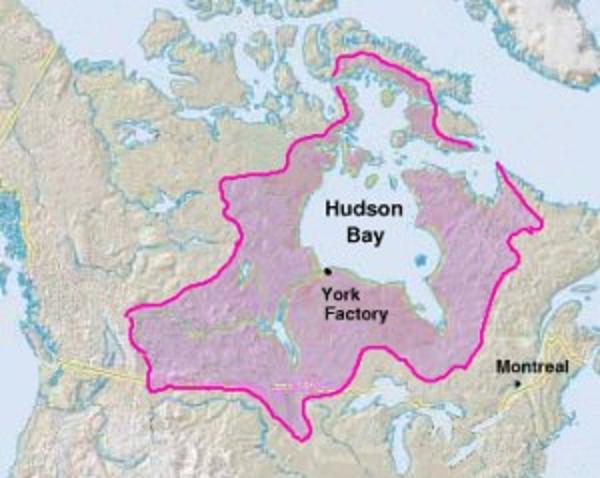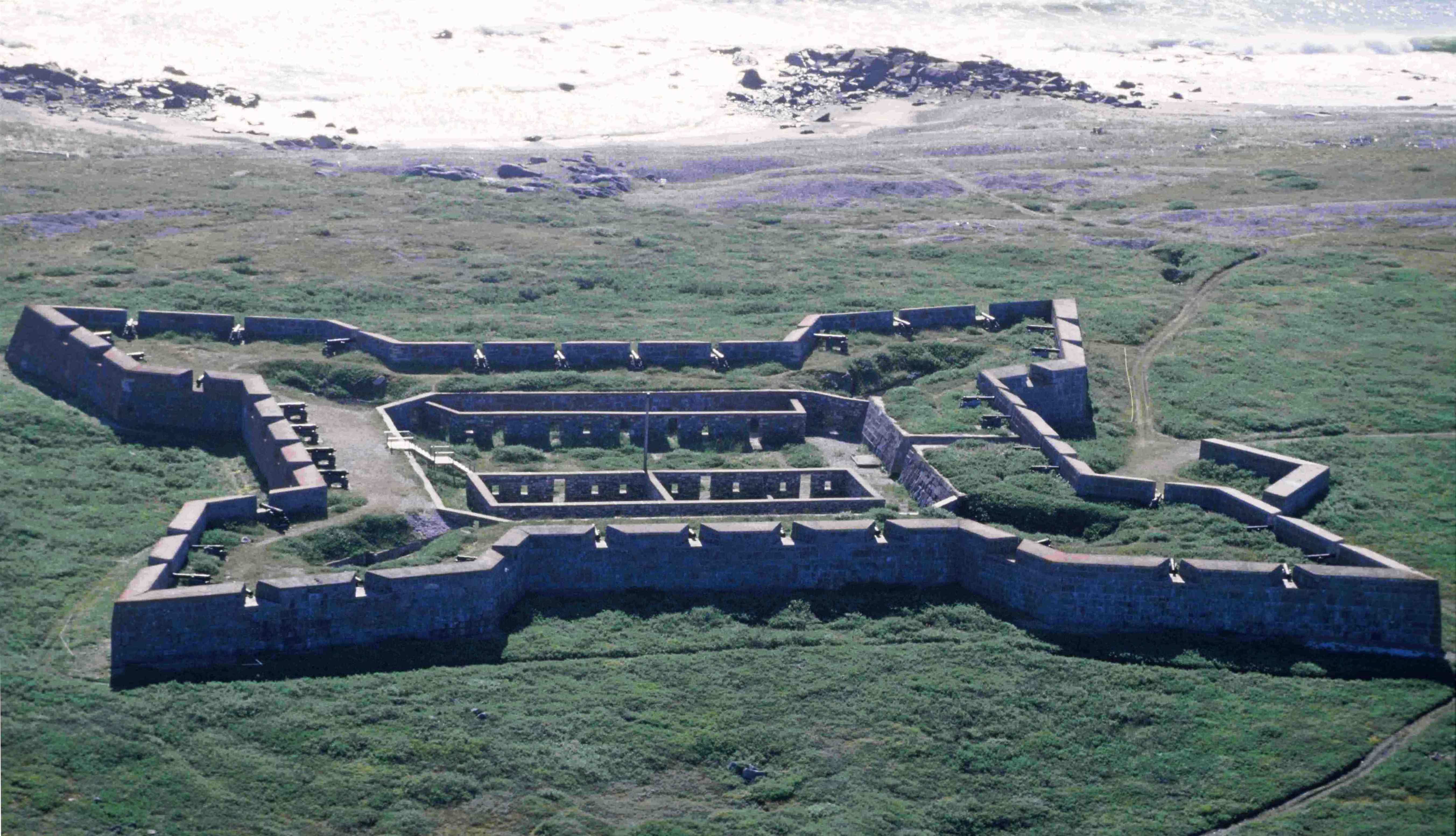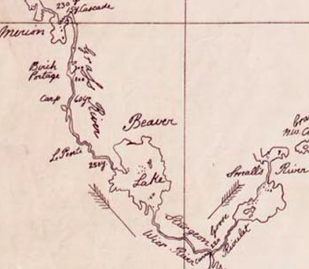|
Louis Primeau
Louis Primeau or Primo ( fl. 1749–1800) was one of the first European fur traders on the Churchill River. Primeau Lake in northern Saskatchewan, Canada () is named after him. Little is known of his youth. Morton says that he was born in Quebec of an English father and French mother, but the DCB does not repeat this. Career Toward the end of the French period in the 18th century, Louis Primeau was trading on the Saskatchewan River at the far western edge of trade and exploration. He spent much time with the Indians, i.e., First Nations people. When the French and Indian War broke out in 1756, as the North American front of the Seven Years' War between Britain and France, most of the French officers were recalled to Quebec. But, Primeau stayed in the west and tried to maintain the fur trade. Following the war and victory by the British in 1763, the Montreal trade had broken down. Primeau went to York Factory and joined the Hudson's Bay Company (HBC), a British business. From 1765 ... [...More Info...] [...Related Items...] OR: [Wikipedia] [Google] [Baidu] |
Floruit
''Floruit'' (; abbreviated fl. or occasionally flor.; from Latin for "they flourished") denotes a date or period during which a person was known to have been alive or active. In English, the unabbreviated word may also be used as a noun indicating the time when someone flourished. Etymology and use la, flōruit is the third-person singular perfect active indicative of the Latin verb ', ' "to bloom, flower, or flourish", from the noun ', ', "flower". Broadly, the term is employed in reference to the peak of activity for a person or movement. More specifically, it often is used in genealogy and historical writing when a person's birth or death dates are unknown, but some other evidence exists that indicates when they were alive. For example, if there are wills attested by John Jones in 1204, and 1229, and a record of his marriage in 1197, a record concerning him might be written as "John Jones (fl. 1197–1229)". The term is often used in art history when dating the career ... [...More Info...] [...Related Items...] OR: [Wikipedia] [Google] [Baidu] |
Frobisher (surname)
Frobisher is an occupational surname, a variant form of 'furbisher', i.e. a person who 'furbishes' (burnishes) weapons and armour as part of the production process (Middle English ''fourbishour'', from Old French ''forbisseor'').''Dictionary of American Family Names'' ©2013, Oxford University Press Notable people with the surname include: *Benjamin Frobisher (1742–1787), Canadian fur trader *Benjamin Joseph Frobisher (1782–1821), Canadian fur trader and politician, son of Joseph Frobisher *Joseph Frobisher (1740–1810), Canadian fur trader and politician, brother of Benjamin and Thomas Frobisher *Martin Frobisher (c. 1535 – 1594), English sailor and explorer *Thomas Frobisher (1744–1788), Canadian fur trader, brother of Joseph and Benjamin Frobisher Fictional characters: *Arthur Frobisher, villainous billionaire in the television series ''Damages (TV Series), Damages'' *Buck Frobisher, character in the television series ''Due South'' *Robert Frobisher, composer i ... [...More Info...] [...Related Items...] OR: [Wikipedia] [Google] [Baidu] |
1749 Births
Events January–March * January 3 ** Benning Wentworth issues the first of the New Hampshire Grants, leading to the establishment of Vermont. ** The first issue of ''Berlingske'', Denmark's oldest continually operating newspaper, is published. * January 21 – The Teatro Filarmonico, the main opera theater in Verona, Italy, is destroyed by fire. It is rebuilt in 1754. * February – The second part of John Cleland's erotic novel ''Fanny Hill'' (''Memoirs of a Woman of Pleasure'') is published in London. The author is released from debtors' prison in March. * February 28 – Henry Fielding's comic novel ''The History of Tom Jones, a Foundling'' is published in London. Also this year, Fielding becomes magistrate at Bow Street, and first enlists the help of the Bow Street Runners, an early police force (eight men at first). * March 6 – A "corpse riot" breaks out in Glasgow after a body disappears from a churchyard in the Gorbals district. Suspicion fa ... [...More Info...] [...Related Items...] OR: [Wikipedia] [Google] [Baidu] |
Coureurs Des Bois
A coureur des bois (; ) or coureur de bois (; plural: coureurs de(s) bois) was an independent entrepreneurial French-Canadian trader who travelled in New France and the interior of North America, usually to trade with First Nations peoples by exchanging various European items for furs. Some learned the trades and practices of the indigenous peoples. These expeditions were part of the beginning of the fur trade in the North American interior. Initially they traded for beaver coats and furs. However, as the market grew, ''coureurs de bois'' were trapping and trading prime beavers whose skins were to be felted in Europe. Evolution While French settlers had lived and traded alongside Indigenous people since the earliest days of New France, coureurs des bois reached their apex during the second half of the 17th century. After 1681, the independent coureur des bois was gradually replaced by state-sponsored voyageurs, who were workers associated with licensed fur traders. They trave ... [...More Info...] [...Related Items...] OR: [Wikipedia] [Google] [Baidu] |
Canadian Canoe Routes (early)
This article covers the water based Canadian canoe routes used by early explorers of Canada with special emphasis on the fur trade. Introduction European exploration of Canada was principally by river. The land has many navigable rivers with short portages between them. There are no serious barriers to water-borne travel east of the Rockies. The fur trade, principally in beaver, drove and financed exploration and initial settlement. Traders obtained furs from the natives and exported them to Europe. Canada and Siberia Both Canada and Siberia are largely covered by Boreal Forest. Both were opened up by water-borne fur traders. In both countries the problem was to find streams that flowed in approximately the right direction and to find short portages to move from one river basin to the next. Both regions are flat. One can move from the Saint Lawrence to the Rockies or from the Urals almost to the Pacific with only a few short portages. In both countries furs were obtained by n ... [...More Info...] [...Related Items...] OR: [Wikipedia] [Google] [Baidu] |
Northwest Company
The North West Company was a fur trading business headquartered in Montreal from 1779 to 1821. It competed with increasing success against the Hudson's Bay Company in what is present-day Western Canada and Northwestern Ontario. With great wealth at stake, tensions between the companies increased to the point where several minor armed skirmishes broke out, and the two companies were forced by the Government of the United Kingdom, British government to merge. Before the Company After the French landed in Quebec in 1608, spread out and built a fur trade empire in the St. Lawrence basin. The French competed with the Dutch (from 1614) and English (1664) in New York and the English in Hudson Bay (1670). Unlike the French who travelled into the northern interior and traded with First Nations in their camps and villages, the English made bases at trading posts on Hudson Bay, inviting the indigenous people to trade. After 1731, pushed trade west beyond Lake Winnipeg. After the British ... [...More Info...] [...Related Items...] OR: [Wikipedia] [Google] [Baidu] |
Kississing Lake
Kississing Lake is a lake in western Manitoba, Canada, approximately northeast of Flin Flon. The Kississing River drains it northeast into Flatrock Lake on the Churchill River (Hudson Bay), Churchill River. The community of Sherridon is on its eastern shores, and the Kississing Lake Indian Reserve is on the western side. Kississing is a Cree language, Cree name meaning "cold". It has historically also been called Cold, Kissisino, or Takipy Lake. The lake is the main resource for Sherridon residents, since it is home to several fishing lodges and outfitters, and used by commercial fishermen, trappers, and wild rice growers. Geography Kississing Lake lies near the height of land on the southern edge of the drainage basin of the Churchill River, and is part of the Hudson Bay drainage basin, Hudson Bay watershed. Although its total area is only , the lake spreads over a considerable extent of territory, due to long irregular bays and arms that extend on all sides of Kississing Lake. ... [...More Info...] [...Related Items...] OR: [Wikipedia] [Google] [Baidu] |
Lac Île-à-la-Crosse
Lac Île-à-la-Crosse is a Y-shaped lake in North-Central Saskatchewan, Canada, on the Churchill River. At the centre of the Y is the town of Île-à-la-Crosse, the second oldest town in Saskatchewan. The Churchill exits the north-east arm and flows east to Hudson Bay through a series of lakes. The Churchill enters at the north-west arm called Aubichon Arm or Deep River. Upstream it leads north-west to Athabasca Country passing Churchill Lake, Peter Pond Lake, Lac La Loche and on to the Methye Portage leading to Lake Athabasca. The Beaver River comes from the south and west and enters on the east side. The headwaters of the Beaver are south-west between the upper Athabasca River and the upper North Saskatchewan River in the Lac la Biche area in Alberta. Lac Île-à-la-Crosse is reached from the south by Saskatchewan Highway 155 which follows the Beaver River. To the south-east is Lac la Plonge and to the south-west Canoe Lake. To the east are many lakes which are widenin ... [...More Info...] [...Related Items...] OR: [Wikipedia] [Google] [Baidu] |
Churchill, Manitoba
Churchill is a town in northern Manitoba, Canada, on the west shore of Hudson Bay, roughly from the Manitoba–Nunavut border. It is most famous for the many polar bears that move toward the shore from inland in the autumn, leading to the nickname "Polar Bear Capital of the World" that has benefited its burgeoning tourism industry. Geography Churchill is located on Hudson Bay, at the mouth of the Churchill River on the 58th parallel north, far above most Canadian populated areas. Churchill is far from any other towns or cities, with Thompson, approximately to the south, being the closest larger settlement. Manitoba's provincial capital, Winnipeg, is approximately south of Churchill. While not part of the city, Eskimo Point and Eskimo Island are located across river with the former site of the Prince of Wales Fort. History A variety of nomadic Arctic peoples lived and hunted in this region. The Thule people arrived around the year 1000 from the west, the ancestors of the presen ... [...More Info...] [...Related Items...] OR: [Wikipedia] [Google] [Baidu] |
Athabasca Indians
Athabaskan (also spelled ''Athabascan'', ''Athapaskan'' or ''Athapascan'', and also known as Dene) is a large family of indigenous languages of the Americas, indigenous languages of North America, located in western North America in three areal language groups: Northern, Pacific Coast and Southern (or Apachean). Kari and Potter (2010:10) place the total territory of the 53 Athabaskan languages at . Chipewyan language, Chipewyan is spoken over the largest area of any North American native language, while Navajo language, Navajo is spoken by the largest number of people of any native language north of Mexico. ''Athebaskan '' is a version of a Cree language, Cree name for Lake Athabasca ( crm, Āðapāskāw, script=Latn '[where] there are reeds one after another'), in Canada. Cree is one of the Algonquian languages and therefore not itself an Athabaskan language. The name was assigned by Albert Gallatin in his 1836 (written 1826) classification of the languages of North America. H ... [...More Info...] [...Related Items...] OR: [Wikipedia] [Google] [Baidu] |
Frog Portage
Frog Portage or Portage du Traite was one of the most important portages on the voyageur route from eastern Canada to the Mackenzie River basin. It allowed boatmen to move from the Saskatchewan River basin to the Churchill River basin. The Churchill then led west to the Mackenzie River basin. The fur trade route ran from Cumberland House, Saskatchewan north up the Sturgeon-Weir River. At its source the 300-yard Frog Portage ran, with a 20-foot drop, to Trade Lake on the Churchill a few miles west of the mouth of Reindeer River. The route then ran at least 250 miles northwest up the Churchill to Methye Portage which led to the Mackenzie basin. For background, see Canadian canoe routes (early). The name is said to come from a dried frog skin that the Cree Nation put up in derision of the Chipewayan's incompetence in preparing beaver skin. The name Traite (trade) comes from Frobisher's coup (see below). Today there are still a plank road and push car. There is a cairn at the Churc ... [...More Info...] [...Related Items...] OR: [Wikipedia] [Google] [Baidu] |
Sturgeon-Weir River
The Sturgeon-Weir River is a river in east-central Saskatchewan, Canada. It flows about south-southeast to join the Saskatchewan River at Cumberland House, Saskatchewan. It was on the main voyageur route from eastern Canada northeast to the Mackenzie River basin. The river is a popular wilderness canoe route in Canada. Description The river's source is Corneille Lake, near the community of Pelican Narrows. It travels southeast, crossing Saskatchewan Highway 106 before reaching Amisk Lake. It then continues southeasterly to Sturgeon Landing and Namew Lake. It runs through the Churchill River Uplands ecoregion which is located along the southern edge of the Precambrian Shield. The area contains continuous coniferous and boreal forest, consisting of closed stands of black spruce and jack pine and a ground cover of mosses and lichens. Local relief rarely exceeds 25 m, but there are ridged steeply sloping rocky uplands and lowlands with exposed bedrock throughout. Wildlife incl ... [...More Info...] [...Related Items...] OR: [Wikipedia] [Google] [Baidu] |



.jpg)


